A reader writes:
why do some things glow brightly in colours OTHER THAN BLUE when illuminated by a blue LED flashlight? Is it fluorescence? But doesn't that only happen under ultraviolet light?
Does this mean my blue LED flashlight has UV output? it's incredibly bright, but is it actually even brighter and more dangerous than it looks?
Ant
First up: I highly recommend coloured LED flashlights. They let you do this!

The above animation accurately reproduces what it was like for me selecting the images to use to illustrate this post, except I was doing it fullscreen on a 30-inch monitor, and so almost neutralised my neurons.
(If you're using Chrome and are now hammering away on the escape key in a desperate attempt to make this brain-slapping animation stop, allow me to suggest the GIF Stopper extension.)
In the olden days, the only coloured portable lights normal humans could afford used an incandescent bulb, with a coloured filter over it. This was incredibly inefficient, and usually didn't even give you one tightly-defined wavelength of light. Your green-filtered flashlight probably still emitted some red and blue.
Today, you can get high-intensity coloured LEDs with a very tight band of output frequencies; no blue in your green, no green in your red. I think the best-value options are the coloured variants of the Ultrafire 501B lights.
I reviewed a white 501B years ago here, but this line of lights still sells well today, because they're basically just SureFire knockoffs with standardised lamps and battery compartments. So you can today buy a white 501B that's quite a bit brighter than the one I reviewed, or upgrade your old 501B with a newer interchangeable lamp, or stick a cheap coloured Ultrafire lamp in your old SureFire incandescent flashlight, et cetera. As long as you stick with a single 18650 lithium rechargeable or two rechargeable or non-rechargeable 123-size cells. Any cheap LED module that's meant to fit in a a flashlight like this should work.
(As Fallingwater points out in the comments, there are also lamps this same shape that want a very different input voltage, and the dirt-cheap lamps may not work very well for various reasons. I think all of the cheap coloured lamps are for one or two lithium cells, though, and they're low-powered by "tactical flashlight" standards so don't have heat problems either. These lamps work from one or two cells because they have a multi-voltage driver. Incandescent bulbs are not this tolerant. Standard small two-123-cell SureFire-type lights with incandescent bulbs will produce a dim orange light from a single 18650. If you somehow manage to drive an incandescent bulb from twice as many cells as it expects, it will die immediately.)
Here's an eBay search that finds a bunch of coloured Ultrafire flashlights and lamps. The lamps start at $US9.99 delivered, but a whole flashlight (without batteries) is under $US15 delivered.
A red, a green and a blue Ultrafire 501B, plus three 18650s and a charger from eBay will only cost you about $US50 all told. The cheapest dealers all have free shipping, too, so you can buy the lights one at a time and not lose any money.
I'd really get all of them, though, and I don't even go to raves. It's just so much fun chucking large amounts of coloured light around. And yes, you do get a pretty decent white-ish light if you shine them all at the same thing.
(See also the positively antiquated Technology Associates "Rave'n 2", which I reviewed more than ten years ago and which I think they still sell. It's still fun, too.)
So. Where was I? Oh yes, fluorescence.
Fluorescence happens when a substance absorbs some kind of radiation, usually light, and then emits light of its own.
It happens when the incoming energy, usually a photon, "excites" an electron to a higher quantum state. When the electron then "relaxes" back to its ground state, it loses some energy to heat and emits the rest as a new photon.
Since the energy and frequency of a photon are directly related, and the outgoing photon is less energetic than the incoming one was, one-photon fluorescence like this only works "downward" in the ROYGBIV spectrum. You'll only see visible-light fluorescence when you're illuminating a fluorescent object with light closer to the blue end of the spectrum than the colour the object fluoresces.
("Upwards" fluorescence is actually possible, when two photons are absorbed but only one emitted. I think this is pretty much unknown in everyday, visible-light fluorescence, though.)
Ultraviolet light is beyond the blue end of the visible spectrum, so it can cause fluorescence in any visible colour. But there's no rule that says the incoming light can't be visible; it just has to be further up the spectrum than the colour of fluorescence it creates.
So here are some brightly-coloured objects from around my house, illuminated by tungsten-filament bulbs. Some of the dyes used to colour many modern polymers are highly fluorescent; shining an ultraviolet light around your house is the best way to find them, but a blue LED flashlight will do a good job too.
A red flashlight's no use, though. It's probably possible for red light to cause visible fluorescence that's even deeper into the red, but you'd probably need a spectrometer to distinguish it from simple reflection of the illuminating light.
Here, we see what basic colour theory says we should. All we're seeing is the red light that bounces off the scene, so everything is shades of red, and the less red there is in the colour of an object, the less of the incoming light will bounce off it and the closer to black it will look.
Go to green light, though - not even blue! - and suddenly fluorescence is happening. The red Gakken mini theremin (as hard to play as a full-sized theremin, but with the mellow, soothing tone of a Stylophone! Buy one today!), and the red rubber Escher's solid (sold as a dog chew toy, of all things, at my local discount shop), and the red crooked dice, are behaving as basic colour theory says they should. There's no green in them, so they look black.
The orange parts of the Nerf guns, though, are cheerfully fluorescing under the bright green light.
(Actually, only the little "Secret Strike" is a Nerf product; the double-barrelled gun is a Buzz Bee Double Shot
, which ejects the empty shells when you break it open!)
I think the yellow parts of the toy guns may be fluorescing a bit under green as well. They mainly look yellow only in comparison with the fluorescing orange plastic (as per this amazing optical illusion), and my digital camera certainly isn't a calibrated colourimeter, but there's still a significant amount of red in there with the bouncing green. That adds up to at least a yellow-ish green.
The length of red paracord (useful for all sorts of things, and also the only flexible string I've found that Joey's little razor teeth don't go straight through) and the carapace of the crab Hexbug, aren't as fluorescent as the plastic, but they're having a go.
Oh, and check out the two Hoberman Switch Pitch balls. One is green and orange and is fluorescing a little and reflecting rather more in the green light; the other is blue and magenta, and is hardly fluorescing at all.
(The Switch Pitch is, I think, one of the greatest fiddle-toys ever invented. I know this post's littered with affiliate links, but seriously, buy a Switch Pitch, if you can. Not everything Hoberman make is a classic; the Brain Twist, for instance, is a worthy attempt at Hoberman-ifying a Rubik's Cube, but I reckon it's more of an ornament than a toy. But the Switch Pitch and the tougher, hard-to-find Switch Kick, are brilliant.)
OK, on to the blue light that started this interminable thing.
Now the lower-fluorescers from the green-lit shot are fluorescing with more enthusiasm, the things that never fluoresced in the green are still sticking to pre-quantum-physics colour theory, and the orange plastic has gone nuts. There's a pretty sizeable energy gap between LED-blue and that orange, so it's sucking up and spitting out electrons photons with great enthusiasm.
My own store of quantum energy ran out before I made an actual UV-lit version of the picture, but I could pretty much just Photoshop one up in less time. All of the fluorescing things in the blue-lit image would look much the same under UV, and everything else would be invisible. Or, more realistically, you'd see everything else in faint blue, because the ultraviolet compact-fluorescent lamps I've got here emit a fair bit of visible blue-violet light along with the UV.
You can get UV LEDs that emit proper near-UV light (not the more dangerous UV-B or even more dangerous "germicidal" UV-C) with very little visible output. Most "UV" LED flashlights use cheaper purple LEDs, though, which may have a bit of near-UV output but basically just do what a blue LED light does, only more so.
And yes, you can get UV Ultrafires, too, but I don't know which flavour of "UV" LED they contain.
Psycho Science is a regular feature here. Ask me your science questions, and I'll answer them. Probably.
And then commenters will, I hope, correct at least the most obvious flaws in my answer.
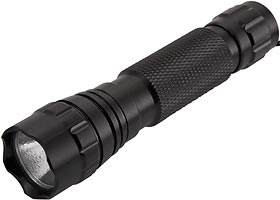
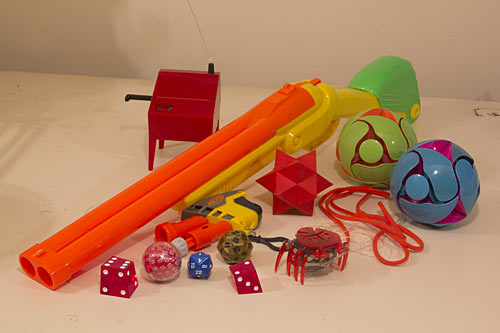
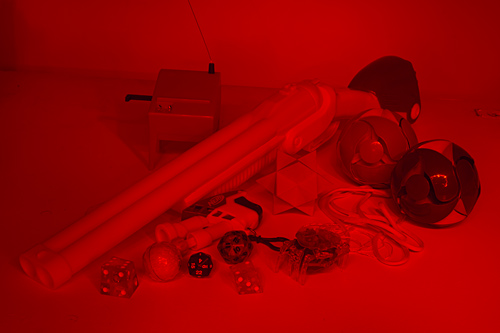
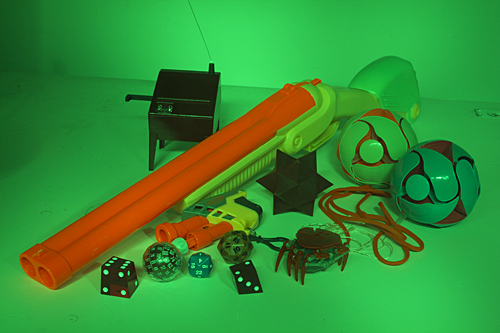
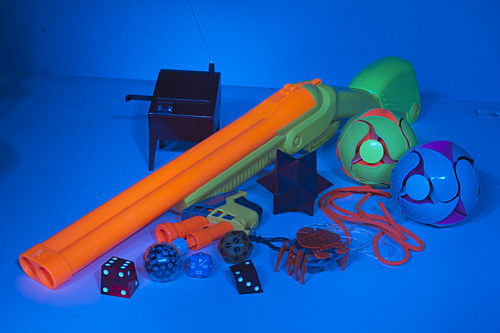
26 July 2012 at 6:58 pm
Thought I'd point out a few things about lights using P60 drop-ins, such as the Ultrafire 501 and countless others:
- you can't make any assumptions about the voltage of the drop-in. Some can take anything from one primary CR123 to four 18650s (losing some efficiency to the multi-voltage regulator), others are made just for one LiIon and won't even run from a primary; if they're also too hot for smaller cells, this restricts them to just one 18650. Look at the product page; if that is not available experiment with a variable power supply (and cross your fingers).
- most have lousy heatsinking. I have no doubts that SureFire bodies mate perfectly with SureFire dropins and transfer heat well (you'd want them to, for the money), but Chinese bodies and Chinese dropins come in all sorts of slightly different sizes. Often the only thermal contact you can expect them to make is through the terminal springs. A 3W LED might survive a decent time in there, but I've seen things like nine-watt MC-E LEDs in dropins that had a big fat insulating layer of air between themselves and the rest of the body. *shudder*
- This problem can usually be made less terribad (I'm fond of the word "terribad", by the way) by wrapping the dropin in aluminium foil until it solidly contacts the outer body. This is far from an optimal thermal solution, but a damn sight better than nothing at all. Still wouldn't run a MC-E like that, though.
- Even then, the surface on which the LED sits is often dangerously thin. The same MC-E dropin I mentioned earlier has a laughably thin "bottom"; even if it had perfect transfer with the outer body, it's far too thin to effectively transmit to it all the heat from the LED.
- If you happen to have a P60 light with lousy heatsinking and a weak LED and would like it to make MOAR light, a cheap and effective solution is this. Incandescents don't much care about heatsinking and this particular one makes rather a lot of light; it's inefficient compared to LEDs, of course, but with a beefy 18650 powering it that's not much of a problem, and it's very cheap. I put one in the flashlight that originally housed the aforementioned MC-E dropin and it's been my light of choice in the rare occasions when I need a beam colour that doesn't make everyone look like zombies.
27 July 2012 at 9:53 am
Nice post, it was enjoyed.
I think when you wrote "There's a pretty sizeable energy gap between LED-blue and that orange, so it's sucking up and spitting out electrons with great enthusiasm." you meant to put "photons" instead of "electrons". these things aren't getting ionized after all.
27 July 2012 at 12:23 pm
Fixed. Obviously, I meant to say magnetic monopoles.
13 August 2012 at 11:00 am
Thanks for this Dan - reminded me that I never got around to buying an Ultrafire when you first reviewed them, so I've fixed that by buying one 501b and one 502b. They should turn up in the next 2 weeks or so.